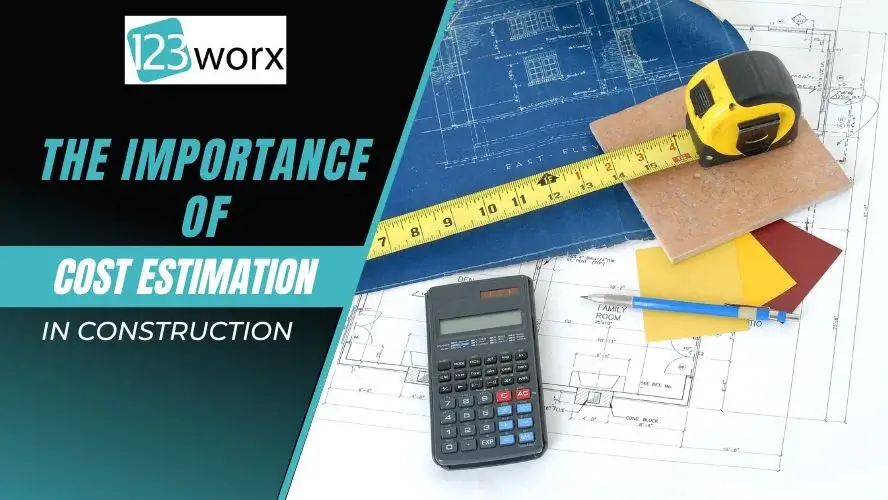The construction industry is such that a cost estimate forms one of the fundamentals through which the viability and success of a project are conducted. It can be a small residential building or some massive commercial complex; these cost estimates can directly impact a project’s financial stability, timeline, and outcome.
Here, we’ll discuss the vital importance of cost estimation in construction and the significant factors and benefits.
What is Cost Estimation in Construction?
Construction cost estimation involves predicting the financial outlay needed to complete the project. The cost components are material, labor, equipment, overheads, and contingencies.
The primary purpose is to provide the total outlay realistically to ensure it is financially feasible and enough funds are provided for the project.
The Role of Cost Estimation in Construction
1. Project Planning and Budgeting
Cost estimation lies at the core of the initial planning and budgeting stage in the construction process. A well-planned budget helps allocate resources effectively, anticipates possibilities, and keeps the project moving efficiently without any financial encumbrance. Besides, it doesn’t go beyond the set timelines or inflate costs.
2. Project Feasibility Analysis
One must determine the feasibility of a construction project before embarking on it. Hence, accurate cost assessments provide crucial insights into the project’s worthiness regarding budget and expected outcomes. This forms an essential analysis for stakeholders, investors, and financiers, as it spearheads a decision to invest or allocate money for the project.
3. Resource Allocation
Proper resource allocation is a crucial point for the practical completion of any construction project. The cost estimation breaks down all costs into materials, labor, and equipment that must be allocated to a given project to use resources for the correct application. This prevents wastage, optimizes resource utilization, and enhances project efficiency in an overall manner.
4. Risk Management
Construction projects are unsafe by nature, as they involve risks of cost overruns, delays, and certain events that are usually not noticeable. This is where risk evaluation comes into play in a thorough cost forecast. It helps identify the potential risks and what they could cost. With this knowledge, the owner can consider steps to limit these risks and keep the project moving forward, even with uncertainties.
5. Bid Preparation and Contractor Selection
Cost estimates are significant to bid preparation and contractor selection in competitive bidding environments. They form the basis on which contractors prepare their competitive bids, and owners use them to evaluate and compare proposals. It’s like a fair scorecard—everyone gets to play, which ensures healthy competition and provides the best possible price.
6. Project Monitoring and Control
Estimating costs during construction phases helps to monitor and control project expenses. You can spot differences in estimated costs, which can be determined from actual and estimated costs, and correction measures can be handled as soon as possible. In such a way, the project is completed on schedule and within the planned budget.
Benefits of Accurate Construction Cost Estimation
1. Financial Stability
A precise estimation of the construction cost will ensure that the project is sufficiently financed without any financial deficit or hitches. It provides economic stability for the smooth running of the project and its timely completion.
2. Enhanced Decision-Making
Providing accurate cost estimates to stakeholders helps them clearly understand the project’s financial requirements. As a result, smart decisions about resource allocation, savvy choices, and proactive risk management are improved.
3. Improved Stakeholder Confidence
Investors, lenders, and clients are likely to want to be associated with a project that possesses dependable and credible cost estimates themselves. They will have a deep faith in the project, thus leading to its good relations and partnership.
4. Reduced Risk of Cost Overruns
Cost overruns are a common challenge in construction projects, often leading to financial strain and project delays. By making accurate cost estimates, it helps to identify potential cost factors and ways to control them. This minimizes the risk of exceeding cost overruns and helps maintain financial order.
5. Optimized Resource Utilization
Cost estimation gives a clear view of resource needs. It helps use resources like materials, workers, and equipment efficiently. This cuts down waste and boosts work output, which helps the projects run smoother and more effectively.
Methods of Construction Cost Estimation
1. Preliminary Estimate
A ROM estimate is used at an early stage of a project. It is an estimate made before the ability to develop an estimate based on a well-defined scope with detailed information is at your disposal. With a little bit of information, it gives a rough idea about the project’s potential cost. It is helpful in initial feasibility studies and planning budgets.
2. Detailed Estimate
A detailed estimate is a comprehensive and accurate projection of a project’s cost based on detailed drawings, specifications, and scope of work. It involves creating a thorough list of expenses tied to every part of a project, painting a clear financial picture. This technique is key in finalizing the budget and preparing project bids.
3. Unit Cost Estimation
Calculating the price per unit is about figuring out the expense for every bit of work displayed, such as per square meter or cubic meter. This method becomes efficient in repetitive work and standard components because the cost per unit is clearly proven. This method often applies to residential and commercial constructions.
4. Parametric Estimation
Parametric estimation is a technique through which project costs are estimated using statistical models and historical information. The method makes estimates better by linking project costs to things and parameters, such as size, duration, and complexity. This method is useful in large-scale and complex projects.
5. Bottom-Up Estimation
Bottom-up estimation is the process of breaking down a project into smaller components. Each small component gets a price estimate. Afterward, all these small individual estimations tags merge together to create the complete project budget. The method is accurate and detailed; it is appropriate for projects with well-defined scopes and specifications.
Challenges in Construction Cost Estimation
1. Incomplete or Inaccurate Data
It’s a big challenge: completing and accurately storing data. Incomplete or inaccurate data may result in erroneous estimation, which can adversely affect a project’s apparent financial health and timeline.
2. Complexity of Projects
Figuring out such projects can be tricky because of all the connected parts and variables involved. This will be calculated by considering the several factors involved in the estimation, such as site conditions, labor availability, and all material prices.
3. Market Fluctuations
Material price changes, shifts in labor expenses, and economic alterations can heavily influence cost predictions. The job of estimators is to consider these changes, creating safety measures to soften their impact.
4. Unforeseen Circumstances
Unforeseen factors, ranging from bad weather to regulatory/permitting changes to site-specific considerations, may affect project costs. This means that a complete risk assessment and contingency planning should be carried out in preparing accurate cost estimates.
Best Practices for Accurate Cost Estimation
1. Comprehensive Data Collection
The detail regarding the scope of work, materials and labor specifications, and equipment will be required, hence the estimator’s job is to provide these details. They ensure nothing gets overlooked in the cost.
2. Use of Technology
BID software and Building Information Modeling (BIM) technologies are two new tools introduced recently to provide more exactness in cost estimation. This software keep live data on each part of the project and largely automates all tasks tied to the figures.
3. Historical Data Analysis
Cost historical data from projects of a similar nature provides valuable insights into cost trends and patterns. Estimators can make use of this data to improve accuracy and reliability regarding the different estimates of the future.
4. Regular Updates and Reviews
The estimates need to be updated and reviewed frequently throughout the project’s life cycle. This should make them increasingly accurate and reflective of changes and modifications in scope, specifications, and market conditions.
5. Collaboration and Communication
If teamwork is adequate and good communication among the stakeholders, cost estimates tend to be the most accurate. Estimators figuring out the costs need to work closely with the designers, builders, people in charge, and buyers. They get information from these people to make sure their guesses are right.
Cost estimation is one of the most important activities that drive the success of the construction project management process, as it helps by giving a clear idea of financial requirements for proper planning and resources. The cost estimation also helps in lowering risks, leading to smarter choices and steadiness in money matters that ensure the project can be finished without problems.
To make these guesses as accurate as possible, you can adapt to new methods and use top-notch technology such as Construction Cost Estimating Software. This ensures projects finish on time, within the money limit, and with the satisfaction of all stakeholders.

As a Vice President at 123worx, Construction Management Platform, Bharat Rudra has worked with hundreds of business executives searching for best-suited software for their construction business with a wide array of requirements. Bharat takes pride in helping construction businesses solve their business and project management challenges. Feel free to reach Bharat if you have any questions. You can find him on LinkedIn or reach him at brudra@123worx.com

